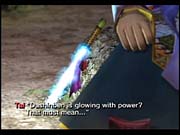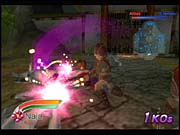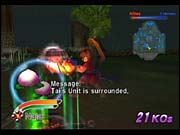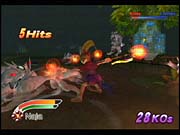Sometimes localization teams have their work cut out for them. These people, whose job it is to take a game made in a foreign country and translate it, have to redo the text, the voice acting, and the manual at the very least. A good team works to convey the cultural nuances found in the game as well. So a game like Mystic Heroes, steeped in Chinese myth unfamiliar to Westerners, must be a real challenge. While the localization team for Mystic Heroes wasn't up to that challenge, the game itself stands well on its own. The end result is an action game with appealing and simple gameplay but with flat characters and no connective tissue.

Koei, the developer of Mystic Heroes, is well known for making games based on actual events from the Three Kingdoms period of Chinese history, with a few fantasy elements thrown in. Mystic Heroes, while nearly identical to Koei's Three Kingdoms-based Dynasty Warriors series in terms of gameplay, is pure fantasy. The action can be described as a mix between Gauntlet and a moderately complex fighting game: Like in Gauntlet, you take on the role of a single warrior fighting against a horde of enemies, but instead of just having an attack button and a magic button, you have a decent variety of close-combat moves in addition to both long-range and short-range spells, combos, and defensive moves. The way combat plays out does a good job of putting you in the shoes of an impossibly powerful martial artist, and you'll routinely be dispatching 10 or 20 enemies at a time. The moves are all motion-captured and blend into each other so well that when you get good at the game, you'll be able to pull off some really impressive-looking fights. If you liked the pacing and mechanics of Gauntlet or the old Final Fight style of side-scrolling beat-'em-ups, then Mystic Heroes is a great expansion of and improvement on that sort of gameplay, with lots of well-rendered characters onscreen.
With two single-player modes (story and survival) and a variety of both cooperative and competitive multiplayer modes, it might seem like the game has more variety than its progenitors. But each mode is more or less the same: you versus large numbers of enemies. The exception is the multiplayer versus match, in which you can turn enemies off. On top of that, not only are there just four playable characters who are somewhat differentiated by combat strength, magic power, and speed, but they also all fight pretty much the same, though two of them are somewhat more suited to close combat, and the other two are slightly more powerful spellcasters.

All four characters can use spells, though, and the spell system clearly shows that Mystic Heroes has a lot of breadth but not much depth. There are four element types for the spells and four different spell categories. A category will have two or three spells of each element type. While this sounds like a lot of spells, your character can use only one spell of each category in a battle. Spells can be used as part of a combo or when your mana meter is full for different effects, but having only four spells per battle can wear a little thin by the time you get to the end.
You pick the spells by choosing two runes before a fight. A rune will have up to four spells on it, one in each category. If both your runes have a spell in the same category, you must pick which one you want to use. While the game boasts more than 70 different runes, the spell abilities that any given rune grants are often also found on many other runes. Furthermore, many of the spells in the same category but of different elements have only minor cosmetic and effect differences--for example, bouncing blue ice crystals instead of arcing red fireballs. Your spell choice does require you to make minute changes in how you play, but the end result is that in single-player and co-op modes, spell use becomes a little repetitive. Against another player, you don't have enough options to be unpredictable. Still, what Mystic Heroes lacks in depth it makes up for with nonstop action. It's even justifiable, considering the bulk of combat is against very weak enemies who don't require a lot of fancy moves to defeat. Yet in a boss battle, or when playing against a friend or just for fun, a little real variety would have extended the playability of the game.
The real disappointment in Mystic Heroes is the story mode. The character development, plot development, and mission progression all seem underdone and unconnected. The problem is that the characters and the story are part of a different culture's mythology. So while a player in Japan might be able to fill in what the game leaves out with his or her own knowledge, most gamers on these shores don't have that luxury. That's when the localization team is supposed to help out with cultural notes and character profiles, but that sort of thing just didn't happen here. There's no back story in the manual or in the game, so unless you're acquainted with the epic Feng Shen Yan Yi, a 100-chapter novel written during China's Ming Dynasty, you won't have any clue about the basis of the game's characters and story line. The game doesn't even tell you that this is where the story comes from. The gameplay doesn't develop the characters very nicely, either. While the extremely well-designed and well-rendered character costumes and weapons give some basic idea of what the characters are like, the voice acting for the characters is awful and doesn't convey much personality at all, especially the player character, Naja. Her voice just doesn't match her looks at all. Her character is the spirit of a dead boy reincarnated as a woman, but if you don't know that already, you won't find it out from the game--that info is nowhere to be found. She'll just sound like a woman trying way too hard to sound like a snotty little boy. Even now that you actually know, it will still sound awful.

The poor localization is not solely to blame for the inscrutable characters and plot. The actual battles could use some extra dramatic touches. The game is certainly capable of them--sometimes when you reach a certain point on the battlefield, a small cutscene will be played, but it's never anything more than a gate opening and troops rushing through it or the appearance of a boss. Furthermore, there are only three kinds of battles: find the exit, beat the boss, or defeat all enemies. There are no secondary objectives. Luckily, the battlefields are well designed and varied. You'll fight on regular battlefields, as well as in more offbeat places like up a staircase, on the rooftop of a castle, on a mountainside, and in a cavern. There's not much story to tie all these various locations together, though, which further puts the lie to the name story mode. In fact, the only real story in story mode is in the prerendered movies between chapters, and while they're bordering on well made (the modeling and art style are high quality, but apparently the motion-capture budget was used only for the game itself, as the animation is done by hand and sometimes isn't that good), they are mostly just a series of scenes that show the next boss character preparing to try to destroy the heroes.

Mystic Heroes has some solid action, but it highlights the major trade-off between itself and its history-based cousin Dynasty Warriors: The fantasy theme allows for more-exciting game elements like huge boss battles and impressive magic attacks, but the historical games can get away with being light on plot and character. Mystic Heroes definitely suffers from Koei's lack of experience in storytelling, but it is still a good game that can be enjoyed both alone and with others.



